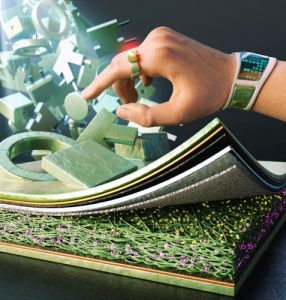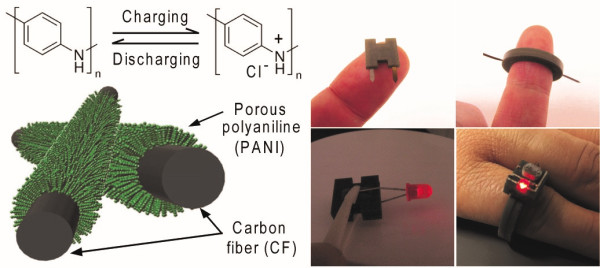With the development of flexible wearable devices comes the need for new battery shapes, as most batteries are currently limited to spherical or rectangular shapes. These shapes do not use space as efficiently as other shapes could, so a team of researchers led by Professor Il-Doo Kim from the Department of Materials Science at KAIST and Professor Jennifer Lewis from the School of Engineering and Applied Sciences at Harvard University have used 3D printing to manufacture batteries with a variety of novel shapes.
These shapes include ring-type, H and U-shaped batteries. Through a research collaboration with Dr. Youngmin Choi at the Korea Research Institute of Chemical Technology (KRICT), these 3D printed batteries were applied to small wearable electronic devices, namely wearable light sensor rings.
 The team adapted environmentally friendly aqueous Zn-ion batteries to make customized battery packs. The system, which uses Zn2+ instead of Li+ as charge carriers, is much safer than rechargeable lithium batteries, which use highly flammable organic electrolytes. The processing conditions of these lithium-ion batteries is also highly complicated, as organic solvents can ignite upon exposure to moisture and oxygen. The aqueous Zn-ion batteries are stable upon contact with atmospheric moisture and oxygen, so they can be fabricated in ambient air conditions. They also have advantages in packaging, since packaged plastic does not dissolve in water even when 3D printed.
The team adapted environmentally friendly aqueous Zn-ion batteries to make customized battery packs. The system, which uses Zn2+ instead of Li+ as charge carriers, is much safer than rechargeable lithium batteries, which use highly flammable organic electrolytes. The processing conditions of these lithium-ion batteries is also highly complicated, as organic solvents can ignite upon exposure to moisture and oxygen. The aqueous Zn-ion batteries are stable upon contact with atmospheric moisture and oxygen, so they can be fabricated in ambient air conditions. They also have advantages in packaging, since packaged plastic does not dissolve in water even when 3D printed.
The researchers used an electrospinning process to fabricate a carbon fiber current collector and uniformly coated electrochemically active polyaniline conductive polymer on the surface of the carbon fiber for a current collector-active layer integrated cathode. The cathode, which is based on conductive polyaniline consisting of a 3D structure, exhibits extremely fast charging speeds, with 50 percent of the charge being completed in two minutes. It can be fabricated without the detachment of active cathode materials, so various battery forms with high mechanical stability can be manufactured.
“Zn-ion batteries employing aqueous electrolytes have the advantage of fabrication under ambient conditions, so it is easy to fabricate the customized battery packs using 3D printing,” said Professor Kim.
The research was published in a paper entitled “High-Power Aqueous Zinc-Ion Batteries for Customized Electric Devices.”
“3D-printed batteries can be easily applied for niche applications such as wearable, personalized, miniaturized micro-robots, and implantable medical devices or microelectronic storage devices with unique designs,” said Professor Lewis.
Most current battery shapes are optimized for coin cell or pouch cells. Since batteries occupy most of the space within microelectronic devices, different shapes are required to fit the new wider variety of devices. The researchers’ success could lead to more of a variety of wearable devices, including very small ones.
In related news, Professor Kim was appointed as an Associate Editor of ACS Nano, in which the article was recently published.
“It is my great honor to be an Associate Editor of the highly renowned journal ACS Nano, which has an impact factor reaching 13.709 with 134,596 citations as of 2017,” he said. “Through the editorial activities in the fields of energy, I will dedicate myself to improving the prominence of KAIST and expanding the scope of Korea’s science and technology. I will also contribute to carrying out more international collaborations with world-leading research groups.”
Authors of the paper include Chanhoon Kim, Bok Yeop Ahn, Teng-Sing Wei, Yejin Jo, Sunho Jeong, Youngmin Choi, Ill-Do Kim and Jennifer A. Lewis.
Discuss this and other 3D printing topics at 3DPrintBoard.com or share your thoughts below.
[Source/Images: KAIST]
Subscribe to Our Email Newsletter
Stay up-to-date on all the latest news from the 3D printing industry and receive information and offers from third party vendors.
You May Also Like
3D Printing News Briefs, April 13, 2024: Robotics, Orthotics, & Hypersonics
In 3D Printing News Briefs today, we’re focusing first on robotics, as Carnegie Mellon University’s new Robotics Innovation Center will house several community outreach programs, and Ugogo3D is now working...
Rail Giant Alstom Saves $15M with 3D Printing Automation Software 3D Spark
3D Spark has entered into a three-year deal with the rail giant Alstom. Alstom, a transport behemoth with annual revenues of $16 billion, specializes in the manufacture of trains, trams,...
Meltio Expands Global Reach with New Partnerships in the Americas and Europe
Spanish 3D printing manufacturer Meltio has expanded its sales network across the globe. With the addition of three new partners in the United States, Brazil, Argentina, and Italy, Meltio aims...
3D Printing Webinar and Event Roundup: April 7, 2024
Webinars and events in the 3D printing industry are picking back up this week! Sea-Air-Space is coming to Maryland, and SAE International is sponsoring a 3D Systems webinar about 3D...

































